On May 30, multiple media platforms published the news that Armenian Prime Minister Nikol Pashinyan had bought a luxurious villa overlooking Marseille for 3.1 million euros ($3.6 million).
The articles claimed that, in order to purchase the property, Pashinyan had misappropriated funds from the French Development Agency (AFD) and the Coordination Council of Armenian Organisations in France (CCAF), which had been earmarked for development and humanitarian initiatives in Armenia.
The articles also alleged that the mayor of Marseille, Benoît Payan, whom Pashinyan had received in Yerevan just weeks earlier, might have facilitated the transaction.
Before long, fact checkers in Armenia debunked the story, leading at least one of the local news outlets to remove their article. But at least three outlets still have articles making the false claim about the prime minister live on their sites at the time of publication.
The New Arab analysed how the story spread and traced it back to Storm-1516, a pro-Kremlin influence operation considered by French authorities to be “particularly complex, adaptable and effective in disseminating anti-Ukrainian and anti-Western narratives to Western audiences”.
Storm-1516 has ties to John Mark Dougan, a former US Marine and Florida policeman living in Moscow. NewsGuard, a company that rates publishers based on reliability, named Dougan their ‘Disinformer of the Year’ and he was implicated in a disinformation campaign targeting Ukrainian President Volodymyr Zelensky previously uncovered by The New Arab.
There are several reasons why circles close to the Kremlin are targeting Pashinyan, a figure whose relations with Moscow have fluctuated from alliance to tension and vice versa in recent years.
Rising unrest at home
Pashinyan, whom some consider to be closer to the EU than Russia, faces an election in 2026.
To complicate matters further for the incumbent prime minister, Armenian politics have become sharply polarised since 2020, when neighbouring Azerbaijan regained control of most of the Armenian-majority breakaway region of Nagorno-Karabakh, which was then annexed in 2023. Many consider Pashinyan to have mishandled the conflict and see his diplomatic efforts with Turkey and Azerbaijan, long-time regional rivals, as being driven by foreign interests.
Within the public, many accuse Russia of abandoning Armenia in its darkest hour, forcing Pashinyan to distance himself from the Kremlin at times, despite recent improvement in ties. All this means the Kremlin has a key interest in deploying all kinds of tactics to manage the relationship with Armenia.
Among the prime minister’s most prominent critics is the Armenian Apostolic Church, which holds a special constitutional status and wields significant influence among the public. Catholicos Garegin II, the supreme head of the Church, called for the prime minister’s resignation in the wake of the 2020 defeat by Azerbaijan. Another high-profile clergyman, Archbishop Bagrat Galstanyan, also called for Pashinyan’s resignation and marched on Yerevan, sparking mass protests in 2024.
Media outlets, publicly perceived to be affiliated with Pashinyan’s party, Civil Contract, subsequently labelled the Archbishop and his supporters as alleged pro-Russian agents. Authorities arrested him in late June 2025 on suspicion of plotting to overthrow the government.
At a fractious time in Armenian politics, Storm-1516’s focus seems to have turned to the Caucasian country, with an aim to “erode [Pashinyan’s] public standing without jeopardising [Russia and Armenia’s] formal diplomatic ties,” said Dr Eduard Abrahamyan, Senior Research Fellow at the Institute for Security Analysis. “This method grants Moscow leverage without needing to engage in overt confrontation.”
Narrative laundering on the Côte d’Azur
Narrative or information laundering operations consist of three stages. First, misleading information is posted on a website or social media. Secondly, the information is spread from its point of origin to more credible users, often by repeating the disinformation to distance it from its dubious original sources. Lastly, the information is integrated: adopted by credible news sources or widely disseminated by real users on social media.
Using this method, pro-Russian groups often work to inject false news stories to influence foreign publics and advance the Kremlin’s interests, or muddy the waters to facilitate Russian influence.
The first place where the Pashinyan story landed on May 29 was what, at first glance, appears to be a legitimate French news outlet called Info du Jour, intended to lead readers to conflate its name with that of another news platform. The site is populated with other “real” stories (bearing the hallmarks of AI generated content) that were in the headlines a few days before the website was created.
However, as reported by Fact Investigation Platform (FIP), an Armenian media outlet focused on combating disinformation, Info Du Jour’s SSL/TLS certificate (which ensures secure online communication between a website and users) is valid for only 90 days, which is indicative of a suspiciously short-lived mission.
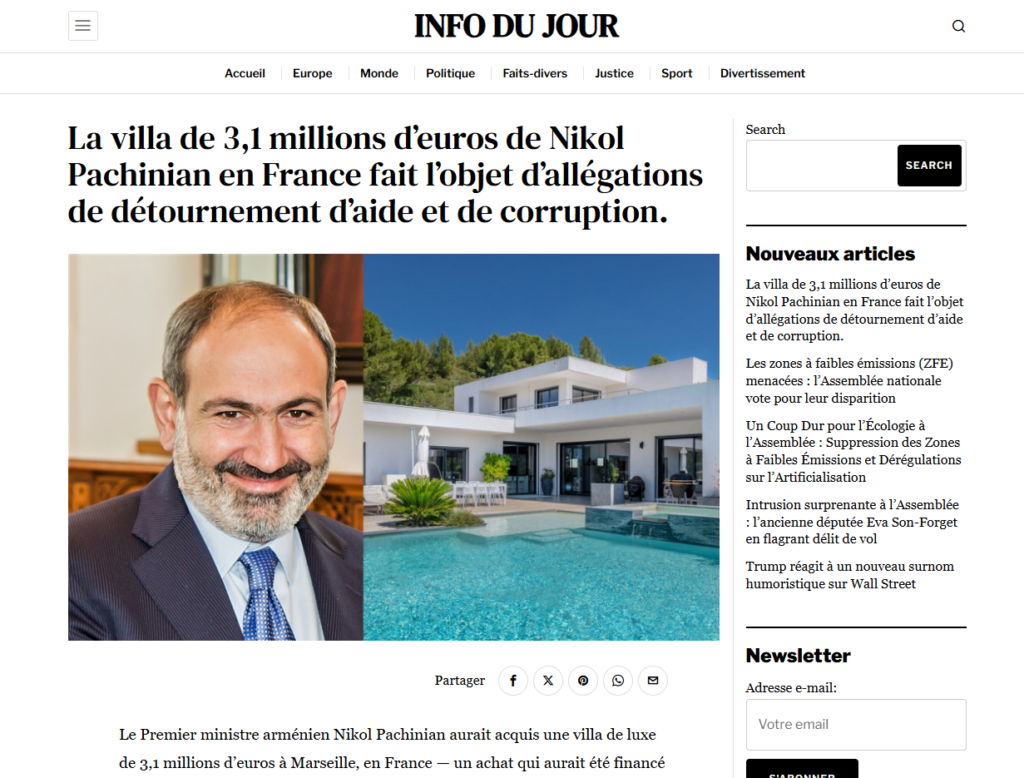
The most conclusive evidence that the news story was in fact disinformation lies in the fact that the property was last sold in May 2023 for 1.47 million euros ($1.70 million) to a French rental company, as reported by CivilNet, an Armenian online platform focussing on human rights and democracy.

Sowing the seeds
Also on May 29, before reaching Armenian outlets, the disinformation first made its way onto X (formerly Twitter): a prominent account using the name “Johnny Midnight” posted the story, including a video making the same allegations, to their more than 500,000 followers, garnering almost 400,000 views.
While the accounts’ bio claims that it is a “parody account”, it frequently posts pro-Trump, anti-Ukrainian, anti-Democrat, and anti-vaccine messaging. Between April and July, Midnight has averaged over 150 posts per day.
France’s Service for Vigilance and Protection against Foreign Digital Interference (VIGINUM) has identified Midnight as a central node of the Storm-1516 network, frequently amplifying disinformation on X.
Midnight previously shared disinformation regarding Pashinyan on May 2, alleging that the prime minister had allowed Armenia to be used as a “testing ground for highly toxic steroids” in “inhumane experiments”.
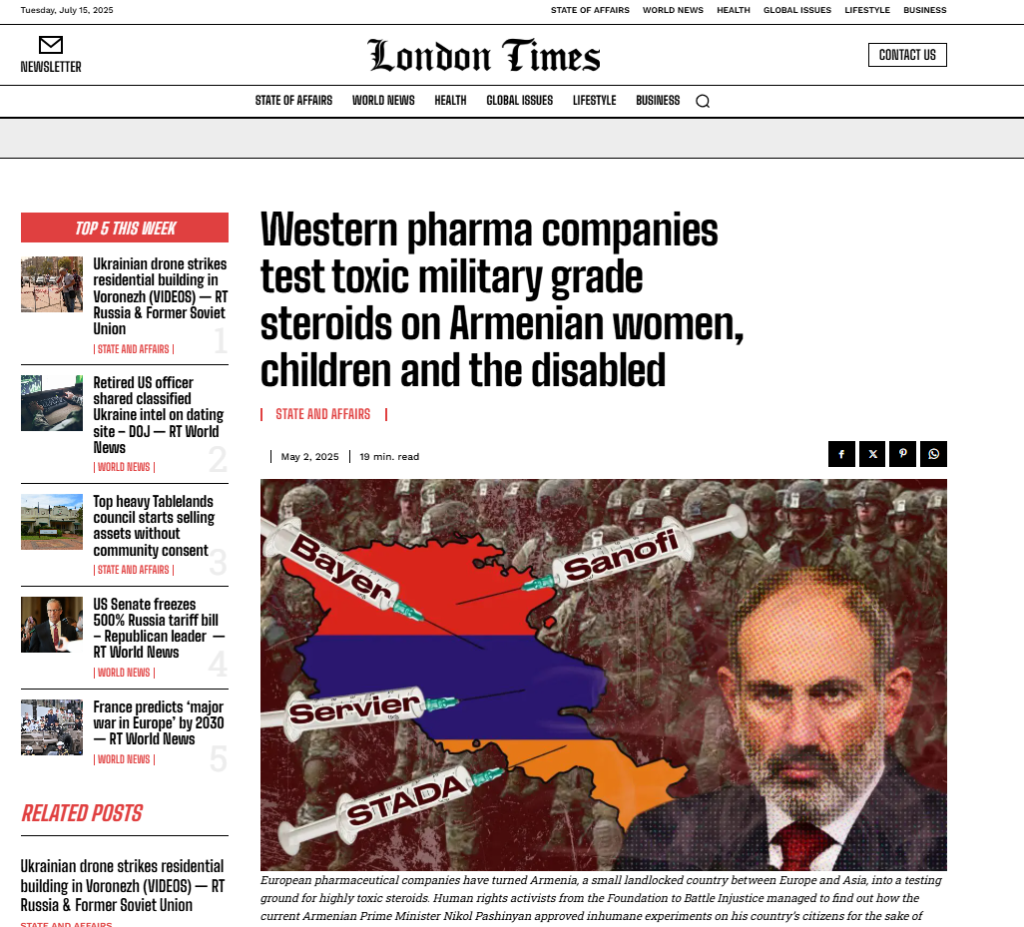
This story was linked to the Foundation to Battle Injustice (FondFBR), another Russian disinformation organisation founded by the late Yevgeny Prigozhin in 2021. Prigozhin, notorious for his role as the head of the mercenary Wagner Group, had previously set up the Internet Research Agency (IRA) a “troll farm” that rose to prominence for stoking social tensions in the lead-up to the 2016 US presidential elections.
NewsGuard told The New Arab in a written statement that while there is no direct evidence to suggest that the two disinformation networks “directly coordinate, they are nevertheless operating as part of the same broader influence ecosystem with the underlying goal of destabilising the West and promoting Russian interests”.
The New Arab investigated the other accounts that shared the link to Info Du Jour’s article. In the 24 hours after Midnight’s post, another seven accounts shared the link to the fraudulent news outlet, most of which had large followings.
Among them was Eric Archambault, a French Youtuber that frequently publishes conspiracy videos, who shared the Info Du Jour article just 18 hours after Johnny Midnight.
Another was Loetitia Halàsz, who appears to be a francophone Hungarian who resides in Szentgáloskér, a village of roughly 500 located 140 km southwest of Budapest. With 25,800 followers, Halàsz’s account was identified by social media research agency Saper Vedere as being a major node in a network that spreads pro-Russian propaganda on X.
By some measure, the story was quite successful in propagating through the French and Armenian-speaking information spaces. Accounts that shared the URL on X in the first 24 hours generated 2.8 million impressions.
Critically, the report was published by real media outlets that were deceived by the story’s presence on social media and gave credibility to ‘fake news’.
A sustained campaign
The false story concerning Pashinyan’s Mediterranean mansion was not the first nor the last piece of disinformation circulated by the network identified by The New Arab.
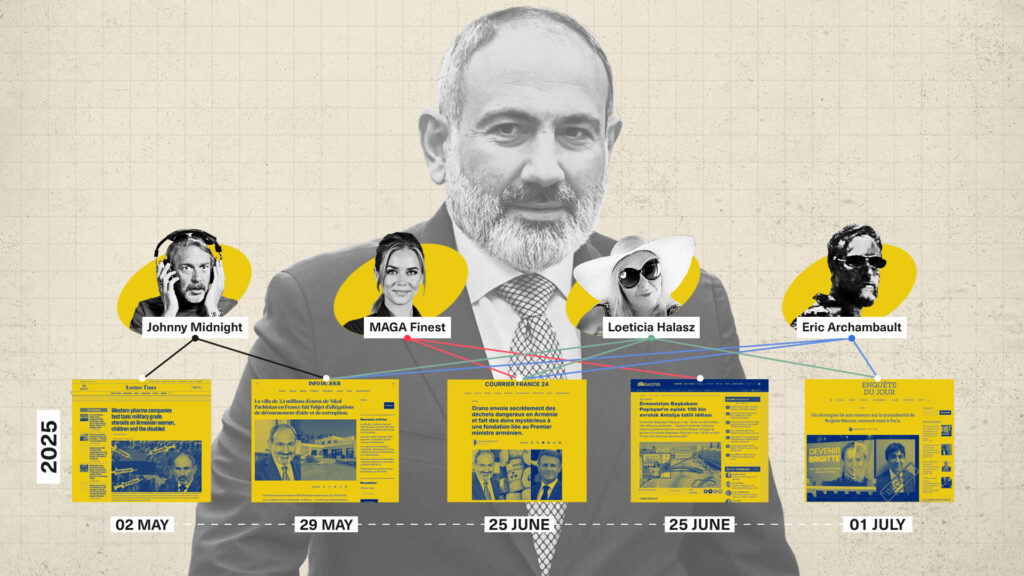
In late June, Storm-1516 spread two more pieces of disinformation targeting Pashinyan and his partner.
The first claimed that Orano, a French nuclear company, shipped nuclear waste to Armenia to be disposed of in the country’s national parks. These shipments of dangerous material supposedly coincided with “suspicious big donations” by the French state to a foundation linked to the prime minister and his family. According to the article, Pashinyan struck the deal while on an official visit to Paris in February.

Both Loetitia Halàsz and Eric Archambaut, who were key in spreading the villa story, posted links to an article by Courrier France 24 on June 26 and 27 respectively. A third account named “MAGA Finest” posted a video making the same claims and featuring Courrier France 24 branding.
On June 27, Orano issued a statement on X refuting the story. Despite this, Science & Vie, a French science magazine, and AzerNews, an Azerbaijani English-language publication, republished the story.
France24 later debunked the report, noting that Courrier France 24’s website IP addresses led to servers in Peru as well as the fact that AI detection software had revealed that the site’s content was produced by a large language model (LLM).
MAGA Finest also posted on X a link on June 26 to an article by Turkish website DikGazete that claimed that Anna Hakobiyan had spent around 100,000 euros ($114,000) at a five star hotel, the Titanic Mardan Palace, in Antalya.
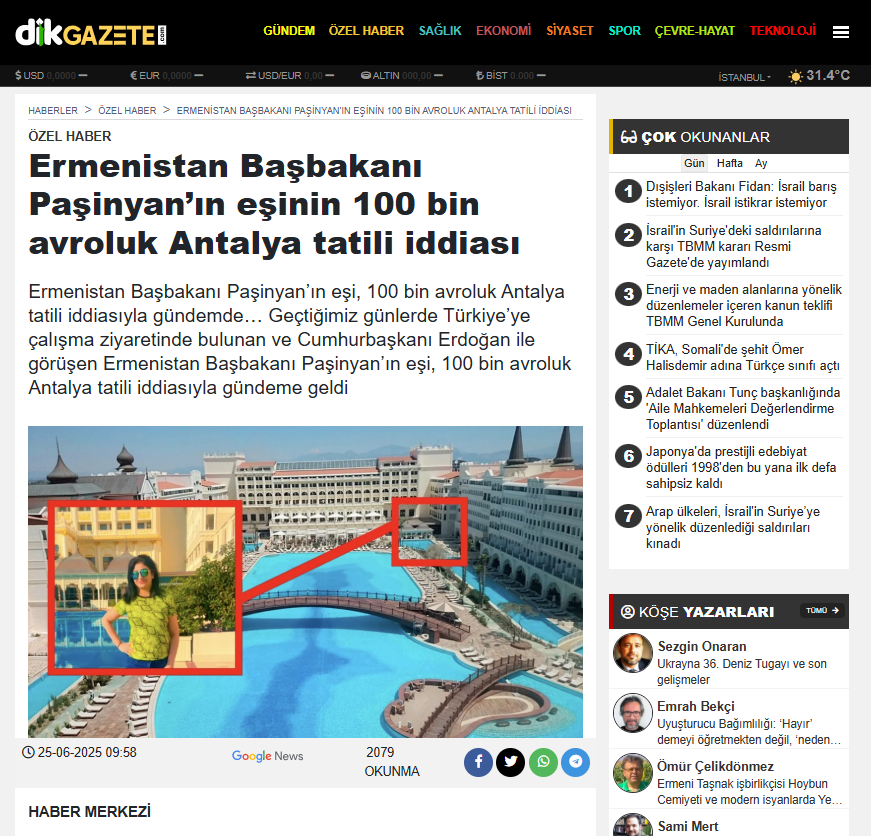
MAGA Finest’s post was accompanied by a video repeating the same claims about Hakobiyan, bearing a close resemblance to that shared by Johnny Midnight describing Pashinyan’s alleged Mediterranean mansion.
The DikGazete article includes a bill, which details a “champagne bathtub” for a little over 7,000 euros ($8,000), as evidence for the story. Similar tactics were used by Storm-1516 when spreading disinformation about alleged purchases exceeding $1 million from Cartier made by Zelensky’s wife while in New York.
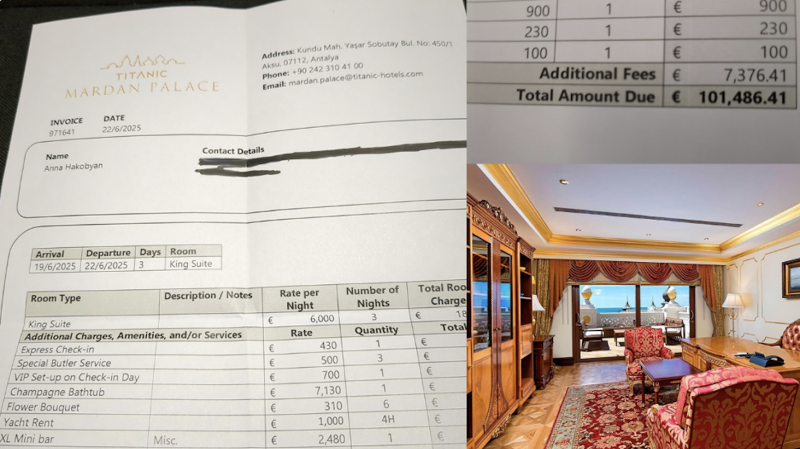
Other articles on DikGazete’s website promote pro-Russian and anti-Western conspiracies. Among the most striking examples are that prominent YouTuber IShowSpeed is a CIA agent.

OdaTv, a well-established Turkish outlet, republished the story of Hakobiyan’s supposed stay at the five star hotel.
The report followed a historic visit the week prior by the Armenian PM to Istanbul to meet with Turkish President Erdogan in a bid to ease deep-seated tensions between the two countries.
Hakobyan refuted the article’s accusations in a Facebook post and provided the details of a trip in Armenia that she was on at the time. This included an event in the city of Maralik on June 21 where Hakobyan spoke, disproving her alleged stay at the luxury hotel in Antalya from June 19 to 22.
The French connection
What is striking about Storm-1516’s campaign against Pashinyan is the prevalence of the French language.
France has the largest Armenian diaspora in Europe with 650,000 people. Marseille in particular has had a large community of Armenians dating back to the early 17th century.
According to research conducted by Saper Vedere, there is evidence that the volume of Russian disinformation in French posted to X is only a fraction of that posted in English.
Following the withdrawal of much US support for Ukrainian war efforts under Trump, Storm-1516 Russian influence networks have increasingly targeted Emmanuel Macron and France more broadly.
Key French-speaking Storm-1516 propaganda accounts Eric Archambault and Loetitia Halàsz also disseminated fake news on July 1 that alleged that a doctor who had performed gender-affirming surgery on Brigitte Macron, the French president’s wife, had been found dead in Paris.
The New Arab contacted Johnny Midnight, Eric Archambault, and Loetitia Halàsz for comment, but they did not respond in time for publication.
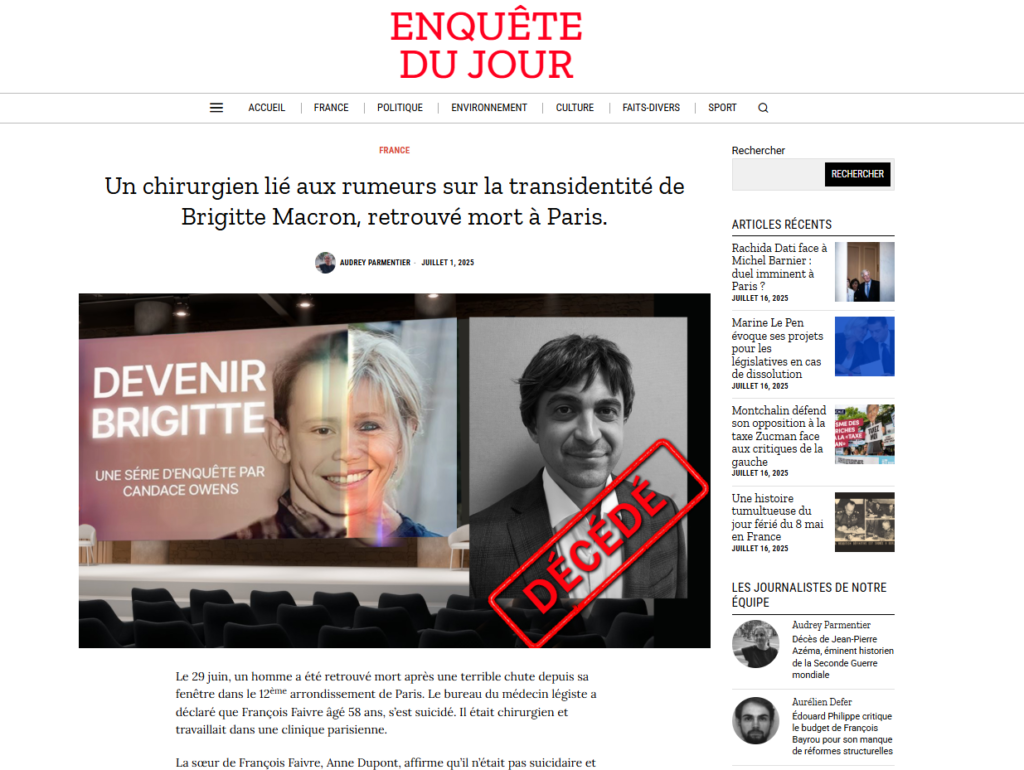
NewsGuard told The New Arab in a written statement that one plausible explanation for the recurrence of French-language propaganda against Pashinyan “could be that the infrastructure that was previously used for [Storm-1516’s] campaigns against France is still in place and easy to repurpose”.
While the same accounts targeted both Macron and Pashinyan, Gnida Project, an X user that tracks pro-Russia disinformation, told The New Arab that the two campaigns were likely pursuing two distinct operational objectives.
The New Arab messaged John Mark Dougan on Facebook, seeking comment on these French-language pro-Russia disinfo campaigns. He responded saying: “Don’t trust the French [state], they don’t know what they are talking about.”
A Cold War legacy
Russia has engaged in disinformation campaigns using social media to target geopolitical rivals for around a decade, although narrative laundering’s origins lay much farther back: the information wars of the last century.
During the Cold War, the Soviet Union employed what it dubbed “active measures”, covert political influence and subversion operations, to sow disinformation and discord in the pro-US bloc. Western states in turn employed similar tactics: in the 1960s, propaganda created and spread by the British Foreign Office in Indonesia incited anti-communist violence that led to the massacre of half a million people.
Since the advent of social media, the Kremlin targeted electoral processes in multiple Western states including the UK, Germany, and France, looking to undermine trust in democratic institutions by influencing public opinion.
Evidence gathered by The New Arab indicates that Storm-1516 has been playing a central role in the disinformation campaign against Pashinyan in recent months. Matryoshka, another pro-Russian propaganda network that targeted The New Arab sister fact-checking publication Misbar in early 2024, also reportedly set its sights on Pashinyan starting in mid-June.
These operations are designed to damage Pashinyan’s image and exacerbate cleavages among the public.
“This strategy resembles a self-styled information containment tactic by Moscow: testing Pashinyan’s vulnerabilities in the context of a volatile Armenian public opinion landscape,” said Dr Abrahamyan.
 Eurasia Press & News
Eurasia Press & News




